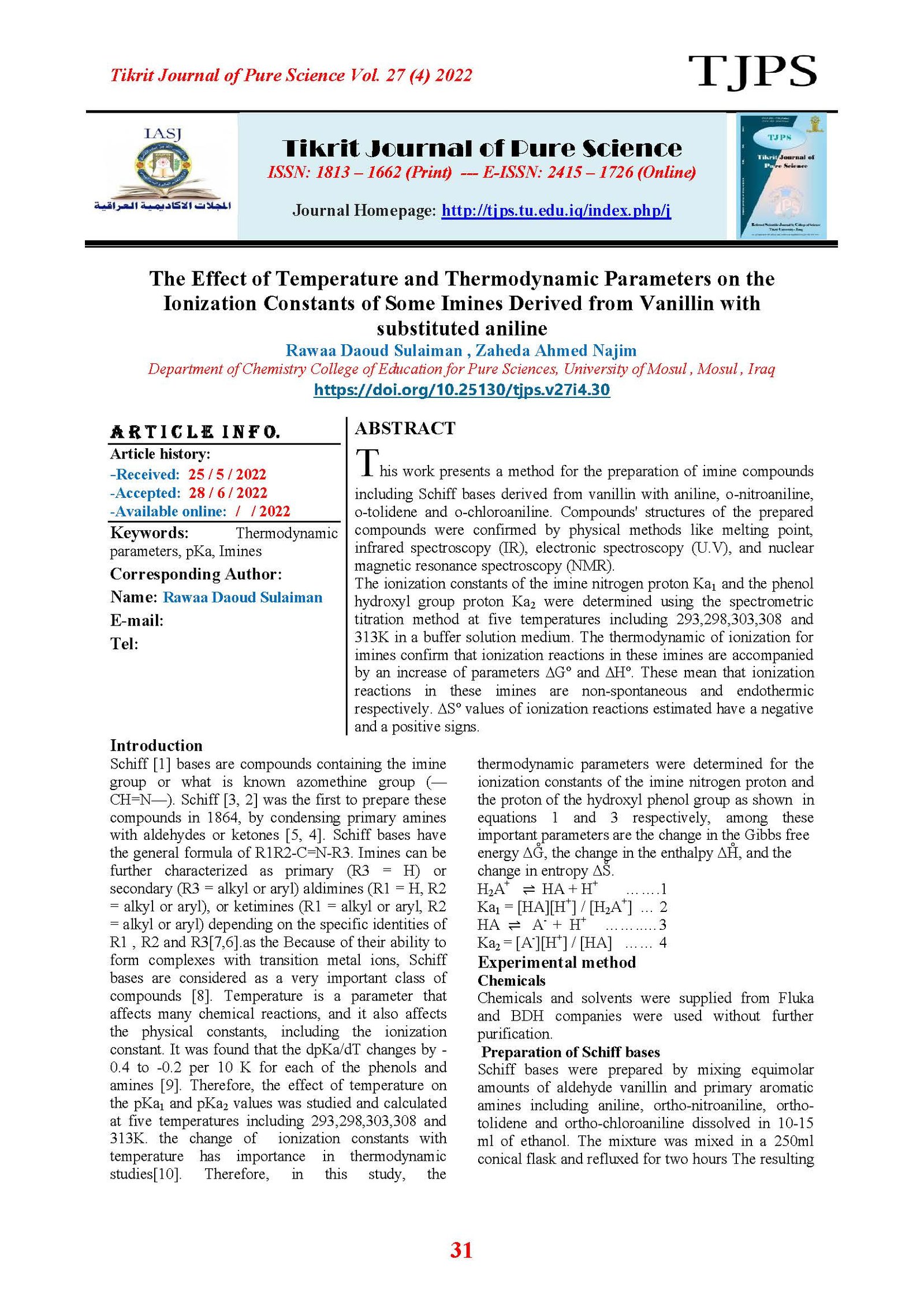The Effect of Temperature and Thermodynamic Parameters on the Ionization Constants of Some Imines Derived from Vanillin with substituted aniline
Main Article Content
Abstract
This work presents a method for the preparation of imine compounds including Schiff bases derived from vanillin with aniline, o-nitroaniline, o-tolidene and o-chloroaniline. Compounds' structures of the prepared compounds were confirmed by physical methods like melting point, infrared spectroscopy (IR), electronic spectroscopy (U.V), and nuclear magnetic resonance spectroscopy (NMR).
The ionization constants of the imine nitrogen proton Ka1 and the phenol hydroxyl group proton Ka2 were determined using the spectrometric titration method at five temperatures including 293,298,303,308 and 313K in a buffer solution medium. The thermodynamic of ionization for imines confirm that ionization reactions in these imines are accompanied by an increase of parameters ∆Gº and ∆Hº. These mean that ionization reactions in these imines are non-spontaneous and endothermic respectively. ∆Sº values of ionization reactions estimated have a negative and a positive signs.
Article Details

This work is licensed under a Creative Commons Attribution 4.0 International License.
Tikrit Journal of Pure Science is licensed under the Creative Commons Attribution 4.0 International License, which allows users to copy, create extracts, abstracts, and new works from the article, alter and revise the article, and make commercial use of the article (including reuse and/or resale of the article by commercial entities), provided the user gives appropriate credit (with a link to the formal publication through the relevant DOI), provides a link to the license, indicates if changes were made, and the licensor is not represented as endorsing the use made of the work. The authors hold the copyright for their published work on the Tikrit J. Pure Sci. website, while Tikrit J. Pure Sci. is responsible for appreciate citation of their work, which is released under CC-BY-4.0, enabling the unrestricted use, distribution, and reproduction of an article in any medium, provided that the original work is properly cited.
References
[1] Süleymanoğlu, N., Demir, E. E., Direkel, Ş., & Ünver, Y. (2020). Theoretical study and antimicrobial activities of New Schiff base derivatives with thiophene. Journal of Molecular Structure, 1218, 128522.
[2] Maity, D. (2019). "Biological Applications of Schiff base Metal Complexes-A Review." International Journal of Research and Analytical Reviews 6(2): 471-478.
[3] Weng, Q., Yi, J., Chen, X., Luo, D., Wang, Y., Sun, W., ... & Han, Z. (2020). Controllable synthesis and biological application of schiff bases from D-glucosamine and terephthalaldehyde. ACS omega, 5(38), 24864-24870.
[4] Ebosie, N. P., Ogwuegbu, M. O., Onyedika, G. O., & Onwumere, F. C. (2021). Biological and analytical applications of Schiff base metal complexes derived from salicylidene-4-aminoantipyrine and its derivatives: A review. Journal of the Iranian Chemical Society, 18(12), 3145-3175.
[5] Torrens-Spence, M. P., Glinkerman, C. M., Günther, J., & Weng, J. K. (2021). Imine chemistry in plant metabolism. Current opinion in plant biology, 60, 101999.
[6] More, M. S., Joshi, P. G., Mishra, Y. K., & Khanna, P. K. (2019). Metal complexes driven from Schiff bases and semicarbazones for biomedical and allied applications: a review. Materials Today Chemistry, 14, 100195.
[7] Nawaz, N., Ahmad, I., Darwesh, N., Wahab, A., Rahman, S. U., Sajid, A., .. & Uddin, K. (2020). Synthesis, Characterization and Antioxidant Activity of Nickel (II) Schiff Base Complexes Derived from 4-(Dimethylamino) benzaldehyde. Journal of the Chemical Society of Pakistan, 42(2), 238-242.
[8] Uddin, M. N., Ahmed, S. S., & Alam, S. R. (2020). Biomedical applications of Schiff base metal complexes. Journal of Coordination Chemistry, 73(23), 3109-3149.
[9] Reijenga, J. C., Gagliardi, L. G., & Kenndler, E. (2007). Temperature dependence of acidity constants, a tool to affect separation selectivity in capillary electrophoresis. Journal of Chromatography A, 1155(2), 142-145.
[10] Azzouz, A. S. P., & Al-Azzawi, N. A. (2002). The Environmental Factors Affecting on pK a Values of Benzaldoximes. Isomerism And Percentage Of Ethanol Effects. J. Edu. Sci.
[11] Cinarli, A., Gürbüz, D., Tavman, A., & Birteksöz, A. S. (2011). Synthesis, spectral characterizations and antimicrobial activity of some Schiff bases of 4-chloro-2-aminophenol. Bulletin of the Chemical Society of Ethiopia, 25(3).
[12] Patel, V., Trivedi, P., Gohel, H., & Khetani, D. (2014). Synthesis and Characterization of Schiff Base of p-chloro aniline and their Metal Complexes and their evaluation for Antibacterial Activity. IJAPBC, 3(4), 999-1003.
[13] Albert, A. (2012). The determination of ionization constants: a laboratory manual, Springer Science & Business Media, Berlin, Germany.
[14] Polster, J., & Lachmann, H. (1989). Spectrometric titrations: analysis of chemical equilibria, Wiley-VCH, New York, United States of America.
[15] Akay, M. A., Canel, E., Kilic, E., & KÖSEOĞLU, F. (2002). Determination of the protonation constants of some substituted salicylideneanilines by the spectrophotometric method in ethanol-water mixtures. Turkish Journal of Chemistry, 26(1), 37-44.
[16] Silverstein, Robert M.; Bassler, G. Clayton; Morrill, Terrence C., (1974), Spectrometric identification of organic compounds, 3ed, John Wiley& sons, New York.
[17] Hadjeb, R., & Barkat, D. (2017). Determination of acid dissociation constants of some substituted salicylideneanilines by spectroscopy. Application of the Hammett relation. Arabian Journal of Chemistry, 10, S3646-S3651.
[19] Azzouz, A.S.P. and Sulaiman, R.D, (2013), Influence of Temperatures and Thermodynamic Parameters on pKa Values for Some Acids and Basic Imines Derived 3-Acetyl and 4-Acetyl Pyridines, Asian Journal of Chemistry; Vol. 25, No. 10, 5303-5306.
[20] Nagai, H., Kuwabara, K., & Carta, G. (2008). Temperature dependence of the dissociation constants of several amino acids. Journal of Chemical & Engineering Data, 53(3), 619-627.
[21] A.S. Azzous and N.A. AL-Azzawi, (2004), “proton liquid ionization constants of 4-carboxy-benzaldoxime by novel potentiometric method”, J. Edu. Sci., 16(2).
